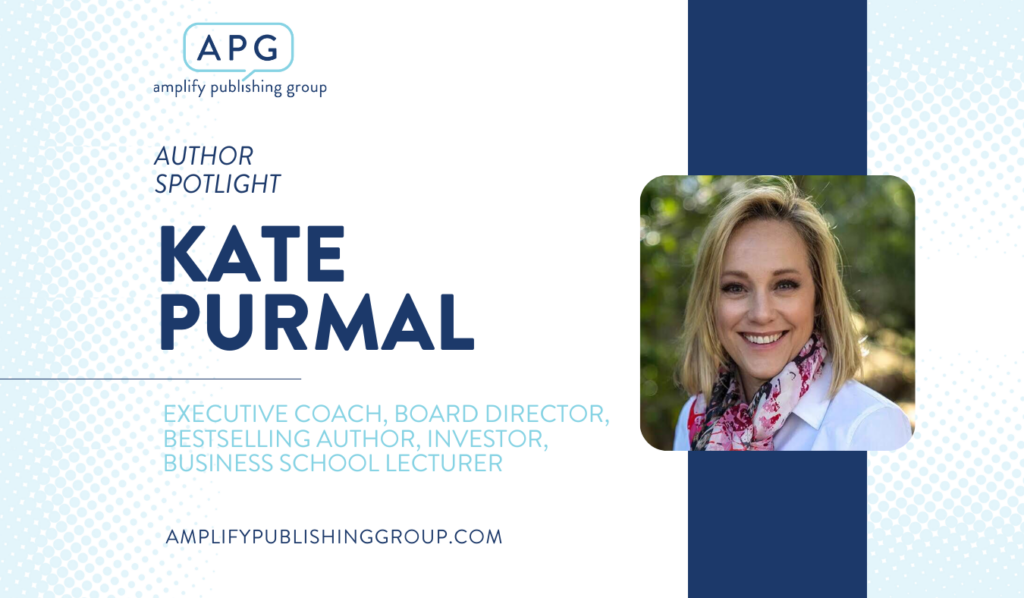Amplify Author Spotlight: Kate Purmal
(Posted on Saturday, February 25, 2023)

We are thrilled to feature Kate Purmal, a distinguished author and business leader with a wealth of experience in executive coaching, business advising, and board governance, in this month’s Amplify Author Spotlight. Kate is a Senior Fellow at Georgetown University and a Board Director at ABD Insurance and Financial Services. Throughout her career, she has been an unwavering advocate for diversity and gender equity in the C-suite. Kate’s impressive professional journey began with her role as a member of Palm Inc.’s founding management team and later as a Senior Vice President at SanDisk. Her extensive experience as a CEO and COO for various start-ups and privately held companies has cemented her position as a leader in the industry. We are excited for you to become acquainted with Kate and gain insights into her personal journey in book publishing and her accomplishments with the release of “Composure”.
What advice would you offer to somebody currently working on a book?
Kate: I would suggest focusing on three areas. First, the content itself is crucial. I think having a great developmental editor who can really capture your voice and work in sync with you in terms of getting the editing done is important. When I was working on my book, Composure, I was fortunate to have someone who could connect the threads of my writing and provide me with elevated feedback that made the book sing.
Secondly, there are a lot of logistics involved in the production component, which is something that I didn’t want to focus on or spend my energy on. It’s not something I’m very skilled at either. So, I found it helpful to have a strong partner who could help with multiple steps such as proofreading, layout, cover design, print readiness, etc. Working with a hybrid publisher gave me more control over the editing, editorial review, and cover design, which was important to me. Also, having control over the time-to-market was crucial since I wanted to get the book out quickly. From the time I completed the manuscript to the book’s printing, it only took about eight or nine months, which is fast.
Thirdly, marketing and promotion can be the hardest part of the process. Finding the right partners and experts to work with on that is essential.
What most surprised you about the process?
Kate: I was surprised by how difficult it was to keep my book in the top ten of a given category and how important reviews are for search rankings. As an author, I had to learn that it’s all about rankings. When people search for your book or the topic of your book, whether or not it shows up on the first page or fifth page of the rankings on Amazon determines whether your book gets purchased or not.
Did Composure lead you to any unexpected opportunities?
Kate: Yes, Composure led me to several unexpected opportunities. We launched the book during the COVID-19 pandemic and noticed that people were too exhausted to read professional development books, especially in hardcover and Kindle format. So, I published my own audiobook the middle of last year and put each chapter on my website as a podcast, which I made available for free. People could listen to the chapters sequentially and then buy the audiobook if they liked it. I noticed a pickup in sales, and the book sold around nine thousand copies in just over a year. The momentum came from people getting the book in their hands and reading it. As a result, I received several inbound opportunities for speaking, executive coaching, and doing internal corporate programs and workshops.
When you originally set out to publish, what was your goal?
Kate: My primary goal with Composure was to elevate women and other traditionally underrepresented groups in the C-suite to elevate their executive presence and make them more effective and promotable. I am passionate about this cause, and I knew I needed to write a book because it seemed like the most obvious way to broaden my reach. I decided to be very generous with giving away my work because I had a dual intention of getting my work out there in the world and helping people utilize it to impact their lives positively and profoundly. I also aimed to promote and serve my own business by making the book as broadly available as possible. I am still a huge believer that if you’re doing a book because you want to improve people’s lives, then open-sourcing or generously giving content is a positive approach that will pay off in unexpected ways.
What’s something people may not know about you?
Kate: Something that people may not know about me is that I got married five years ago to a yacht captain. I’ve become a sailor as a result and have joined him on trips up and down the west coast from Alaska to Mexico to Hawaii. In addition to sailing, I love mountain biking, and I’ve taken on these two new hobbies that I never thought I would enjoy.

What are you currently reading and what book do you most often recommend to others?
Kate: I am somebody who read ten books at a time and I read a lot of nonfiction right now. One of my favorite books is Business Brilliant, which delves into what distinguishes people who have made tens of millions of dollars from the rest of us. The book offers fascinating insights, and one example is that they network two or three levels above themselves, which is something I never thought of as a play to put yourself in a completely different financial round.
–
Learn more about Composure: The Art of Executive Presence: https://www.composurethebook.com/composure-book-the-art-of-executive-presence
Connect with Kate on LinkedIn: https://www.linkedin.com/in/kate-purmal-922133/
May Featured Title: The Conscious Marketer
(Posted on Wednesday, May 20, 2020)
“Brands can no longer market to consumers but instead have to market with them. In order for a brand to do that, it must be conscious of the world in which we all live together.”
Our May featured title is The Conscious Marketer: Inspiring a Deeper and More Conscious Brand Experience by Jim Joseph! We asked Jim about his writing process, how social media is changing the brand experience, and his best tips for brand managers.

1. As the Global President of marketing communications agency BCW (Burson Cohn & Wolfe), and the recipient of Entrepreneur of the Year, Agency of the Year, and Consumer Launch Campaign of the Year (just to name a few), why did you decide to write The Conscious Marketer and share your knowledge with others?
As a passionate leader and follower of brands, I’ve been carefully watching with fascination how marketers are starting to take a stand on social issues. I’ve also had many clients ask if they too should take a stand on social issues. So I decided that this was an issue that I’d like to tackle, as a way for fellow marketers to think about how what’s going on in the world affects their brand activities
2. What was your writing process like for The Conscious Marketer? How did this process differ from your first book with the Mascot/Amplify team, Out and About Dad?
I’m an early riser and an early writer, so I write a lot when I first wake up. And I’m also an editor by nature. Every morning I would write another chapter and then constantly edit it until I felt it was perfect—which is also why I wrote the book in quick little snippets so that people could read it easily piece by piece. My writing process for this book was a bit different than for Out and About Dad where I did most of that writing while I was traveling. That book was more of a long-form story so I wrote in longer segments to get the story to flow together. I’ve learned to love writing!
3. At the beginning of The Conscious Marketer, you tell (or warn) readers that the tone of the book will be casual—like a two-sided conversation. You use a similar style and tone of voice in your blog, where you post frequent, succinct blogs about a wide variety of topics in the marketing world. Why do you think this type of content is so consumable and convenient for readers?
In many many cases, people are reading on the fly and on mobile devices—at least when it comes to business books. My perspective is to give readers the ability to quickly grasp a concept, think about it, apply it to what they are doing, and then move on! I think it’s more actionable that way.
4. You also have a strong following on Facebook, Twitter, and LinkedIn. Why do you think it is important to engage with your audience and post frequent, useful content? How has social media changed the brand experience?
I think that thought leadership should be a constant flow of information, not an occasional brain dump. I like to post content on an almost daily basis so that people can get a little dose of thinking to motivate their work for the day. And then the next day. And then the next day. As for the brand experience and social media, well, social media is the brand experience these days. Particularly in our current COVID-19 world. Everything is online and everything is a two-way dialogue. Social media is a great place to be a brand and to live along side your consumers.
5. What are the main takeaways that you hope readers will understand from the book?
It’s vitally important for a brand to be aware of what’s going on in thier consumers’ lives and take it into account when forming marketing programs. Brands can no longer market to consumers but instead have to market with them. In order for a brand to do that, it must be conscious of the world in which we all live together.
6. What’s next for Jim Joseph? Any future books on the horizon?
I’m thinking about a sequel to Out and About Dad. So many people have asked me if it’s coming, so I’m starting to write it in my mind. I need to decide if it’ll go from my mind to a piece of paper!
Amplify, an imprint of Mascot Books, specializes in game-changing political, business, and current affairs titles. Want to learn more about Amplify? Visit the Amplify website and follow us on Facebook, Twitter, LinkedIn, and Instagram.
Ideas to Bridge the Political Divide
(Posted on Thursday, May 14, 2020)
Neal Simon and Steven Shafarman have concrete and actionable ideas on how to bridge the large (and growing) ideological divide in present-day America. They have outlined their ideas in new books recently published by RealClear Publishing, a new joint venture established by Amplify Publishing, Gotham Ghostwriters, and RealClear Politics.
Here’s a taste of what Simon and Shafarman believe will fix a broken and hyper-partisan political system.
Contract to Unite America
Business executive and 2018 candidate for United States Senate Neal Simon recently published Contract to Unite America: 10 Reforms to Reclaim Our Republic, a call to purge our political system of corruption and partisan politics. Simon breaks down ten practical ways in which we can restore trust and bipartisan ideals in our political system—from implementing term limits to putting restrictions on campaign financing. One of Simon’s main positions? Ranked-choice voting.
The Skinny on Ranked-Choice Voting
TIME magazine defines ranked-choice voting (RCV) as a system that “allows voters to rank candidates by preference, meaning they can submit ballots that list not only their first-choice candidate for a position, but also their second, third and so on.” The results? Simon told CSPAN that RCV “has done a lot to give voters more choice; it’s done a lot to encourage civility in elections, and you end up with more people elected who represent more of the country.” In Contract to Unite America, Simon argues that RCV provides third-party candidates with a platform and prevents the two-party system from dominating election cycles, ultimately encouraging candidates from different parties to work across the aisle for the sake of their constituents.
According to some experts, here’s how it would work. Say you have a gerrymandered district that is dominated by either Democratic or Republican representatives. With multimember districts under RCV, these areas could instead see a mix of representatives—Democrats, Republicans, and independents. As Simon explains further in Contract to Unite America, “Congress would end up with more Republicans from blue states like New York and more Democrats from red states like Texas.” Meaning, RCV would not only give Democrats or Republicans a chance to represent a new district, but it would also encourage these representatives to work together to serve their shared constituents. Simon believes this is a win-win for politicians and voters.
Our Future
Political advocate Steven Shafarman has been a vocal proponent of universal basic income for more than thirty years. In his upcoming book, Our Future: The Basic Income Plan for Peace, Justice, Liberty, Democracy, and Personal Dignity (June 16, 2020), Shafarman discusses how the implementation of UBI would not only improve the quality of life for all Americans, but would also be a source of common ground for Democrats and Republicans.
The Skinny on Universal Basic Income
Universal basic income (UBI) is exactly what it sounds like—a fixed, guaranteed income for all US citizens. UBI was once thought to be a fringe idea, but yesterday’s fringe idea has become one of the government’s key tools in stimulating the economy during the COVID-19 crisis, garnering bipartisan support. As Shafarman notes in his TED Talk, “The idea is to set some amount, say $1,000 a month, and provide that to every adult citizen.” Citing our nation’s founding fathers, Shafarman argues, “In order to truly secure our inalienable rights to life, liberty and the pursuit of happiness, basic income is imperative.” But how could this bridge the political divide?
In Our Future, Shafarman notes that funding for UBI could come from cutting government programs that have become superfluous, appealing to the Republican Party, which prefers less government spending. At the same time, UBI would become a government-funded endeavor, appealing to the Democratic Party, which advocates for big government and the social safety net. In Shafarman’s opinion, the long-term effects of UBI have the potential to lead to bipartisan reform, including improved public health and lowered healthcare costs, a surge in job creation, more successful small businesses, and enduring national security. The idea is simple: We the People versus special interests and the status quo. To Shafarman, it’s a no-brainer.
Ranked-choice voting and universal basic income—two big ideas for political diplomacy from even bigger thought leaders. Simon and Shafarman are leading the conversations, and we look forward to hearing what else they have to say during the 2020 election cycle and beyond. And with our partners at RealClearPolitics we’ll continue to provide political experts like them with a platform to share their big ideas.
Interested in learning more about Amplify’s thought leaders? Check out our authors and upcoming releases.
December Featured Title: Joy of Financial Planning
(Posted on Tuesday, December 17, 2019)
“We have a chance to transform our pessimism into optimism; our confusion into clarity, our passion into action; and our potential into real life success.”
Our December featured title is Joy of Financial Planning by Jason Howell! We chatted with Jason about his extensive political and financial career, his involvement as an alumnus of George Mason University, and how we can reclaim our American Dreams through financial planning.

1. As President of the Jason Howell Company, a CERTIFIED FINANCIAL PLANNER™ professional, and a former U.S. Congressional candidate, you have a very extensive background in finance and politics. What inspired you to share your knowledge with American families through your new book, Joy of Financial Planning?
When I left politics, I became a financial planner so I could make a living while still serving the community. What I found over the years is that only so many people could choose to hire a true financial planner. Writing the book was a way to reach a larger audience who wanted (needed) the information, regardless of their ability to hire a professional.
2. In the preface of your book, you address the idealization of the “American Dream”, and how it has evolved over time as a result of inflation and other economic challenges. What does it mean for us as Gen X’ers and Millennials to reclaim our American Dreams?
It means we have a chance to transform our pessimism into optimism; our confusion into clarity, our passion into action; and our potential into real life success. This generation of adults has so much potential but we need the success principles of financial planning more than any other generation in US history. We face unique economic challenges but we also have unique opportunities. This is the generation that will face the effects of climate change, social unrest and income inequality. The “JOY of Financial Planning” allows us, through intentional actions, to solve problems and create opportunities for ourselves, our families and our communities.
3. You outline the steps that we can take to reclaim our American Dreams in seven distinct parts. Why did you choose to structure the book this way? What was your writing and researching process like?
I separated the book into seven distinct sections so people weren’t overwhelmed. In my family wealth practice, I have found that clients usually come to the table with a particular financial struggle that has their attention. Without that attention, they would have never picked up the phone and I wouldn’t have been able to show them all of their other opportunities. What I wanted readers of the book to be able to do was skip to what has their attention and discover the rest over time. My writing process was a mix of research, personal and professional experience. Unlike many of the other “personal finance gurus” I am still in practice as a CERTIFIED FINANCIAL PLANNER™ professional. This means I face real problems from real families and work to solve them in a current, practical way. And my personal financial situation is reflective of the dual-income professionals my firm tends to attract. Readers will enjoy that the book is a mix of academic, professional and personal content.
4. You are a very active alumnus of George Mason University, where you were recognized as a Prominent Patriot in business and was twice the distinguished alumnus speaker for the School of Business graduating class. During one of your keynote speeches, you notably said the following quote:
“Twenty-one years ago, somebody told me I was going to be an alumnus. I had no idea what that actually meant. I think it means you come back.”
Why do you feel it is so important to give back to your school, and to share your experiences and knowledge with aspiring businessmen and women?
George Mason University was good to me. My experience was more valuable and rich than I expected. I believe everyone of us has value to share and it’s not just a nice thing to do, it is necessary. Academic institutions require resources from the state, from the faculty, from the staff and from the alumni to remain relevant in an ever changing society. Northern Virginia is a great example of a thriving, changing society and “coming back” to Mason is my way of contributing to a community that I have benefited from for over 30 years.
5. What are the key takeaways from the book that you hope will help readers to take ownership of their financial joy and success?
I hope readers recognize that we can still achieve our potential and reclaim their version of the American Dream. And with that reassurance, I hope readers talk more regularly about money with their significant others, write down their personal values and aspirations, balance their priorities and make the best use of their time on earth. I bet you thought I’d say something like reduce debt right? Yes, that’s in the book but the takeaways listed here are just as important.
Get your copy of Joy of Financial Planning at the Amplify Bookstore.
To learn more about Jason, visit www.joyoffinancialplanning.com and www.Jason Howell.com, and follow him on Twitter, Facebook, LinkedIn, and Amazon.
620 Herndon Parkway, Suite 220|
Herndon, Virginia 20170
|
Phone: 703-437-3584|
Fax: 703-437-3554|
info@amplifypublishing.com
All rights reserved.